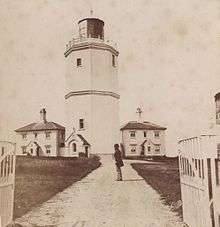Frederick Hale Holmes

Frederick Hale Holmes (born 1812)[1] was a Professor of Chemistry at the Royal Panopticon of Science and Art[2] and pioneer of electric lighting.[3] In 1853 he demonstrated the ability of electro-magnetic generators to provide continuous current to power arc light and in 1856 patented a magneto to power an arc light for lighthouses which he demonstrated to Michael Faraday at Blackwall in 1857.[4][5] His experiments with alternating current arc lighting at North Foreland lighthouse in 1857-60[6] were the subject of a lecture by Michael Faraday at the Royal Institution.[7]

One of Holmes' generators built in 1867 and used at Souter Lighthouse is displayed at the Science Museum, London.[8]
Some web sources give his date of death as 1875[9] however he was recorded as still living at time of 1881 census in which his occupation was noted as "Patentee of Fog Signals".[10] which is confirmed by his filing of a patent in 1881 (granted 1883 in US) for a "Siren for Signalling"[11]
References
- ↑ United Kingdom Census 1861, United States Census, Bloomsbury, Middlesex, England; roll 542565, page 34, piece 58, folio 123,, enumeration district St Martin In The Fields. Retrieved on 23 Apr 2015.
- ↑ Exeter and Plymouth Gazette (3 Sep 1853). "ROYAL PANOPTICON OF SCIENCE AND ART, LEICESTER SQUARE". p. 2.
PROFESSOR FREDERICK. HOLMES will commence Courses of Practical Instructions on the Application Chemistry Farming Pursuits, the Laboratory of this Institution on the 1st September next. The Course of Instruction will include easy methods of ascertaining the quantities of the different substances concerned in the growth of Wheat, &c, present any sample earth, and the most economical means of supplying those ingredients which are found deficient...
- ↑ "Literary Gazette". 23 July 1853. p. 733.
- ↑ "Lighthouse Illumination by Magneto-Electricity". The Dublin Builder. August 15, 1864. p. 14.
In February,1857, Professor Holmes applied to the Trinity Board, and in the following month the electric light was exhibited for several nights the experimental lantern Blackwall, before the Light Committee and Professor Faraday.
- ↑ Cleveland & Morris (15 Nov 2013). Handbook of Energy: Chronologies, Top Ten Lists, and Word Clouds, Volume 2. Elsevier. p. 175.
- ↑ "Lighthouse Illumination by Magneto-Electricity". The Dublin Builder. August 15, 1864. p. 14.
an agreement was made for a trial at the South Foreland, but it was not till the of December that this experiment at an actual lighthouse was commenced... M. Reynaud, the Director-General of the French Lighthouses, inspected the light on April 20, 1859; it was visited by most of the members of the Royal Commission of Lights, Buoys, and Beacons, including myself, three days afterwards, and on the same day Professor Faraday wrote a report to the Trinity House. The opinions expressed were so far favourable that the Elder Brethren desired a further trial of six months, during which time the light was to be entirely under their own control, Mr. Holmes not being allowed interfere in any way. The light was again kindled on August 22
- ↑ "Magneto-Electric Light For Lighthouses". Newcastle Courant. March 30, 1860. p. 3.
Professor Faraday, in a lecture delivered at the Royal Institution, says: "By means of a magnet, and of motion, we can get the some kind of electricity as from the battery; and, under the authority of the Trinity House, Professor Holmes has been occupied in introducing the magneto-electric light in the lighthouse at the North Foreland...For the last six months the North Foreland has been shining by means of this electric light beyond all comparison better than its former light. Never for once during six months has it failed in doing its duty
- ↑ "Holmes's electricity generator, 1867". Retrieved 23 April 2015.
- ↑ "Frederick Hale Holmes". United States Lighthouse Society. Retrieved 22 April 2015.
- ↑ United Kingdom Census 1881, United States Census, Fulham, Middlesex, England; roll 1341016, page 19, piece 71, folio 106,, enumeration district Fulham. Retrieved on 23 Apr 2015.
- ↑ United States Patent Office (10 July 1883). "US281070 A". Retrieved 23 April 2015.
Be it known that I, FREDERICK HALE HOLMES, a subject of the Queen of Great Britain and Ireland, residing at West Brompton, in the county of Middlesex, Kingdom (of Great Britain and Ireland, have invented new and useful Improvements in Sirens or Signaling Apparatus, (for which I have obtained a patent in Great Britain, No. 3, 528, hearing date August 13, 1881, and a patent in France, No. 147,282, hearing date February 9, 1882, signed April 19, 1882,) of which the following is a specification. This invention relates to the construction of signaling apparatus of the kind known as the siren, and apparatus combined therewith for working it automatically